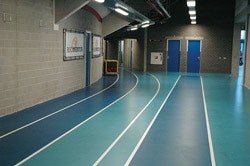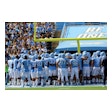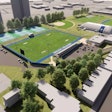Running in the halls is not frowned upon at Whiteland Community High School. In fact, it's encouraged. At least that's the case around the gymnasium spaces at this suburban Indianapolis institution, where resilient sports flooring covers roughly 8,300 square feet of corridor.

Running in the halls is not frowned upon at Whiteland Community High School. In fact, it's encouraged.
At least that's the case around the gymnasium spaces at this suburban Indianapolis institution, where resilient sports flooring covers roughly 8,300 square feet of corridor. This is where the Warriors' track teams train during the often-long winter months.
"We literally use it every day in the wintertime," says WCHS boys' and girls' track coach Brandon Bangel. "Starting in December, the boys will condition three times a week and the girls two times a week, and then the next week it switches."
The season officially begins in mid-February, but there's no telling whether winter will be exhausted or still have some kick left. "There are some years where it's in the mid-40s and we can get outside in the middle of February," Bangel says. "And then there are some years where there are still six or eight inches of snow on the track."
Typically, the team is outdoors for good by the first of March, he adds, but the corridor contingency is available regardless. "When it snows or rains, our track teams can do some stuff in the hallways, which are a little softer for our athletes," says first-year WCHS athletic director Ken Sears. "We're pretty happy with it."
It's all made possible by a decision in 2004 to replace hallway carpeting with a synthetic surface consisting of crumb-rubber mats adhered to the building substrate and then coated with a sealer, a seamless polyurethane resin (applied with a trowel) and a seamless pigmented topcoat wear layer (applied with a roller). The completed product measures a mere 9 millimeters thick and stretches 65 meters down one hallway, makes a right-angle turn and runs another 45 meters - an L shape that wraps around two sides of an auxiliary gym, providing just enough space for Bangel to conduct effective indoor workouts.
"Obviously, it's not an indoor track facility," says Bangel, who has coached at Whiteland since 2007. "It's not like some of the high schools around Indianapolis that put in indoor tracks. We certainly can't get done what those schools get done. But compared to most other schools, it does give us a surface that we can train on. We do a lot of acceleration drills, we can do some sprinting, and we do hurdles. My hurdlers stay twice a week, even after our normal conditioning is over, and we hurdle in the long hallway. It has worked great."
There have been similar treatments incorporated into other sports facilities, including spike-proof training lanes encircling the main pedestrian concourse at Ominisport Apeldoorn, a competition track and cycling venue in the Netherlands. But the conversion of more traditional corridor space for athletic use remains surprisingly rare in the United States.
Now in its ninth academic year, the hallway flooring at Whiteland shows little signs of slowing down (13 small slits were repaired in 2009 at a total cost of $1,000, according to Tim Caldwell, field superintendent at Cincinnati Floor Company, which installed the surface). Says Bangel, "We've dragged 25-pound weighted sleds in those hallways, and once we get done and the janitors come through with a machine that cleans the floor, you almost can't even tell that it's ever been used. It doesn't scratch and mark up very easily."
"The nice thing is you get a seamless hallway surface that can't be attacked by water," says John Ficks, marketing manager for the floor's manufacturer, Robbins Sports Surfaces. "And you also get a soft, tough surface that can be used both for training and for traffic."
Flooring similar to the kind specified at Whiteland - Pulastic Classic 90 - could run a buyer between $9 and $11 per square foot, according to Ficks, or five times as much as what it would cost to install the type of vinyl composite tiles often found in institutional hallways (and which have a checkered safety history when pressed into service within athletic spaces).
WCHS administrators spared the expense of installing an optional spike-proof wear layer, one that Caldwell says "you can attack with a kitchen fork and not hurt it." But Bangel is fine with the flooring he has at his training disposal. "It's a nice surface to train on, but like any surface, when you're doing a lot of training, it's still fairly hard," he says. "So we still have to be very cautious with shin splints. And I think if you have kids in spikes on there, you're just asking to get kids hurt - especially that early in the year. To some extent, I'm almost glad that we can't put spikes on, because we don't even have the option. We stay in our regular shoes. We get done what we need to get done. We condition, and our whole goal in conditioning is to get in shape and prevent injuries. This floor certainly serves that purpose."
Moreover, the surface - unmarked by lane lines, but specified in Whiteland's blue school color - enhances the public perception of the facility, another reason that Bangel would "absolutely" recommend that other schools consider flooring their athletic facility hallways in similar fashion. "The thing I like about it the most is that the flooring looks nice, yet you can still use it on a daily basis," he says. "I know some schools build these really huge athletic entrances to their schools, but no sports are allowed to use that hallway to train in, because it's so nice that they don't want to mess it up. At our school, you come in and see that it's a nice surface. It looks clean. But at the same time we can still use that space to get some things accomplished during the wintertime, which is a must for us. If we didn't have the hallway, then we would literally have nowhere to go."

































